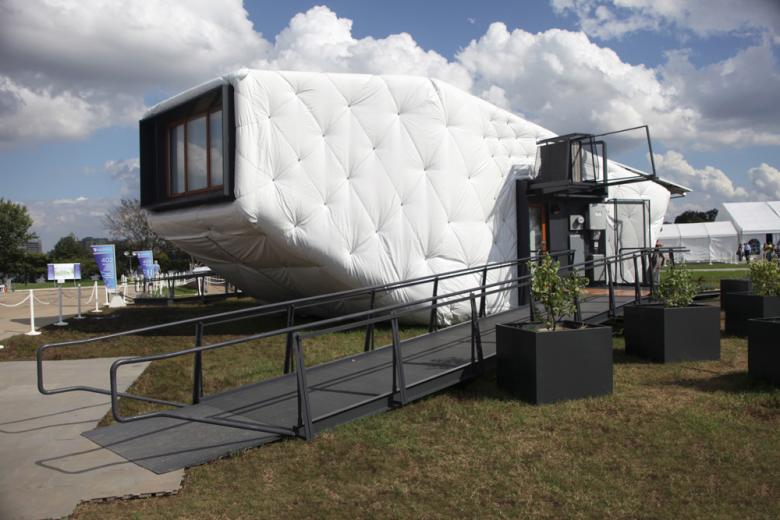Hanwha Solar CHIP by SCI-Arc/CalTech
Hanwha Solar CHIP by SCI-Arc/CalTech
10. October 2011
While the SCI-Arc/CalTech team finished sixth (out of 19 teams) in the 2011 U.S. Department of Energy Solar Decathlon, they created a house whose form and skin belie our assumptions about green building today. By wrapping the angular house in insulation pillows, it puts on display what is normally concealed within the walls. This is one aspect of reconsidering the various factors that contribute to sustainable architecture. The team answered some questions about the building that was recently installed in Washington, D.C. for the competition.
Exterior Photo
What were the circumstances of receiving the commission for this project?
There were two proposal rounds in the Solar Decathlon 2011 competition until the 20 final competitors were chosen. The rules are based on International Residential Code, with some requirements tailored to suit the National Park location, and the short duration of the event. For the 2011 competition we are asked to produce a design with a final construction cost as close to 250K as possible. The program is a residence between 600 and 1000 square feet aimed at a broad market in our region.
Exterior Photo
Can you describe your design process for the building?
Due to the number of individuals involved in this project, it took a lot of exploration to settle on the direction and the details throughout the course of the design, but especially in the conceptual phase. Competing schemes were developed and the resulting final concept incorporated different ideas from each of those schemes. The resulting concept was then developed all the way through to construction documents, including building a full size mock-up to evaluate design decisions. The construction process involved some design changes enabled and sometimes necessitated by our choice to build the house ourselves.
Interior Photo
How does the completed building compare to the project as designed? Were there any dramatic changes between the two and/or lessons learned during construction?
The greatest challenge for the SCI-Arc/Caltech team was to materialize the experimental concept into reality. Through intense research, planning, and testing both digitally and physically at model scale or on our full-scale mockup in the SCI-Arc parking lot, we were able to persevere and bring forth a house without sacrificing the conceptual intent that we deemed important. Despite having a detailed BIM, we anticipated the technical difficulties that would arise with the fabric exterior that could only be resolved during construction. For example, determining how much insulation would be required at certain locations of the house in order to produce the desired puffiness appearance.
Plans/Section Drawing
How does the building compare to other projects in your office, be it the same or other building types?
As an educational experience, this project is unique in the SCI-Arc curriculum in terms of the pace and organization of the studio, and the tangible nature of the final product. We are able to apply the critical design skills we were taught on an actual building at full scale, and not merely on some speculative concept.
Wall Details
How does the building relate to contemporary architectural trends, be it sustainability, technology, etc.?
CHIP challenges any preconception of what a net-zero house is architecturally and technologically. Unhindered by obligations to the common shed or modern box design theme, CHIP’s design team looked to re-invent, reorganize, and reimagining the role of technology, engineering and social priorities of the house, uninterested in that which was already solved and resolved. CHIP brings forth a new idea to disrupt the status quo imagery of the standard American home offering a refreshing new take on alternative future housing for the American homebuyer.
Rendering
Are there any new/upcoming projects in your office that this building’s design and construction has influenced?
SCI-Arc directors are in discussion whether the institution will enter future Solar Decathlons. The competition is a great forum to express the architectural values of the school and any future entries will aspire to be as revolutionary as CHIP is to this year’s competition.
E-Mail Interview conducted by John Hill
Hanwha Solar SCI-Arc/Caltech CHIP
(Compact Hyper-Insulated Prototype)
2011
Washington, DC
Client
U.S. Department of Energy Solar Decathlon 2011
Architect
SCI-Arc/Caltech
Los Angeles
Project Architect
SCI-Arc Students
Advisors Dwayne Oyler & Wes Jones
Project Manager
Reed Finlay & Elisabeth Neigert
Project Team
Southern California Institute of Architecture (SCI-Arc) &
California Institute of Technology (Caltech)
Lanna Semel
Giovanna Orozco
Rachel Bitan
Valentin Florescu
Catherine Cauldwell
Rinaldo Perez
Huy Duc Le
Paul Cambon
Wilson Chang
Michael Nesbit
Michael Piscitello
Nathan Meyers
Robert Cardenas
Geoffrey April
Jane Suthigoseeya
Wes Jones
Dwayne Oyler
Joel Ochs
Robert Gilson
Jacques Lesec
Harris Silver
Hyungbin Im
Fei Yang
Richard Yufan Wang
Andrew Jonathan Gong
Benjamin Bernard Kurtz
Joseph Cole Kelner Hershkowitz
Hassenruck Gudipati
Rachel Millikan
Sara Ahmed
Yuyang Fan
Xing Yue Mou
Samuel Stephen Jones
David Lu
Ka Chuan Suen
Sonal Gupta
Construction Manager
Brian Zentmyer & Scott Davis
PV Panels
Hanwha Solar
Site Area
West Potomac Park (Temporary exhibit)
Photos
Darius Siwek
Drawings / Rendering
Wilson Chang
Related articles
-
Spotlight on Italy
on 5/16/18
-
Bologna Shoah Memorial
on 7/20/15





